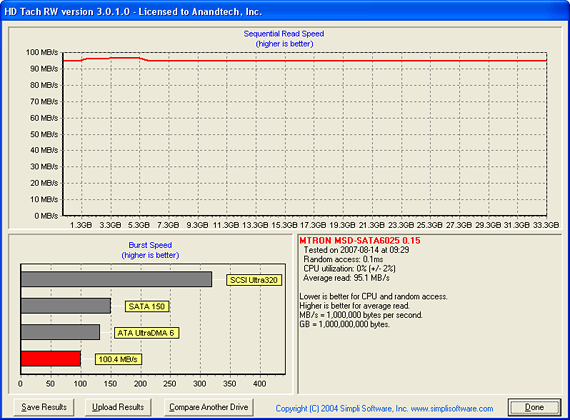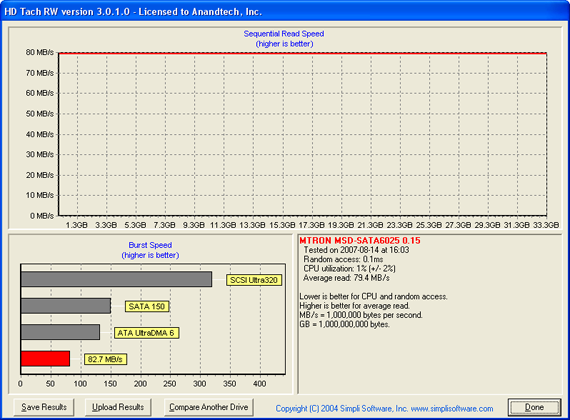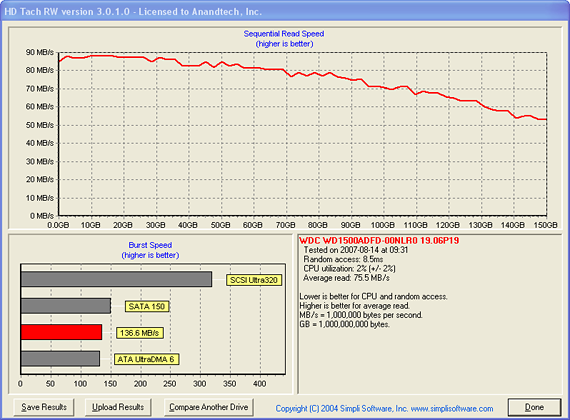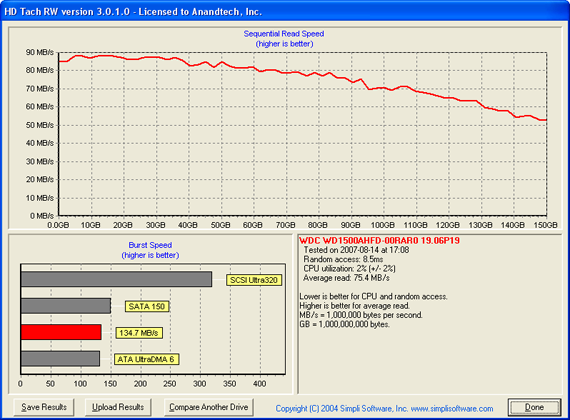MTRON SSD 32GB: Wile E. Coyote or Road Runner?
by Gary Key on August 15, 2007 3:00 AM EST- Posted in
- Storage
HD Tach 3.0
MTRON 32GB SSD NV680i
MTRON 32GB SSD Intel ICH9R
Our first screenshot is the MTRON drive installed on the NVIDIA 680i controller chipset and indicates a sustained transfer rate of 95.1 MB/sec with a burst rate of 100.4 MB/sec. The same drive on the Intel ICH9R scores a sustained transfer rate of 79.4 MB/sec with a burst rate of 82.7 MB/sec. The Intel controller is up to 17% slower with the MTRON SSD drive in this particular benchmark.
We tried several different P35 boards equipped with the ICH9R and a couple of P965 boards with the ICH8R and had the same results where our SSD drives topped out around 80 MB/sec with these particular Intel Southbridge designs. This occurred under Windows XP and Vista with a variety of Intel INF revisions. Our NVIDIA based 680i and 650i boards did not exhibit this particular issue under either operating system.
The MTRON drive features an outstanding access time of 0.1ms or lower which greatly assists in random read times. The lack of higher sustained or maximum transfer rates on the Intel chipsets will adversely affect the drives performance in most of our benchmarks but we must temper our performance expectations as you will see shortly. In the synthetic benchmarks we will find wide disparities in certain tests, but in our actual application tests the differences were rather minimal in most cases.
WD Raptor 150GB NV680i
WD Raptor 150GB Intel ICH9R
We are also including HD Tach results for the WD Raptor 150GB drive for comparison. The differences between the two controller chipsets are extremely minor with this drive and other mechanical drives we have tested to date. The Raptor's sustained transfer rate of 75.5 MB/sec is around 21% lower than the MTRON SSD drive on the NVIDIA controller and about 5% lower on the Intel chipset. The burst rates of the Raptor are about 36% higher than the MTRON unit.
MTRON 32GB SSD NV680i
 |
| Click to enlarge |
MTRON 32GB SSD Intel ICH9R
 |
| Click to enlarge |
Our first screenshot is the MTRON drive installed on the NVIDIA 680i controller chipset and indicates a sustained transfer rate of 95.1 MB/sec with a burst rate of 100.4 MB/sec. The same drive on the Intel ICH9R scores a sustained transfer rate of 79.4 MB/sec with a burst rate of 82.7 MB/sec. The Intel controller is up to 17% slower with the MTRON SSD drive in this particular benchmark.
We tried several different P35 boards equipped with the ICH9R and a couple of P965 boards with the ICH8R and had the same results where our SSD drives topped out around 80 MB/sec with these particular Intel Southbridge designs. This occurred under Windows XP and Vista with a variety of Intel INF revisions. Our NVIDIA based 680i and 650i boards did not exhibit this particular issue under either operating system.
The MTRON drive features an outstanding access time of 0.1ms or lower which greatly assists in random read times. The lack of higher sustained or maximum transfer rates on the Intel chipsets will adversely affect the drives performance in most of our benchmarks but we must temper our performance expectations as you will see shortly. In the synthetic benchmarks we will find wide disparities in certain tests, but in our actual application tests the differences were rather minimal in most cases.
WD Raptor 150GB NV680i
 |
| Click to enlarge |
WD Raptor 150GB Intel ICH9R
 |
| Click to enlarge |
We are also including HD Tach results for the WD Raptor 150GB drive for comparison. The differences between the two controller chipsets are extremely minor with this drive and other mechanical drives we have tested to date. The Raptor's sustained transfer rate of 75.5 MB/sec is around 21% lower than the MTRON SSD drive on the NVIDIA controller and about 5% lower on the Intel chipset. The burst rates of the Raptor are about 36% higher than the MTRON unit.










37 Comments
View All Comments
enovikoff - Thursday, October 29, 2009 - link
I purchased two 7000 series SSDs for running a commercial datacenter (hey, they're billed as "enterprise") Both failed within 3 months and MTRON did not stand behind them. Instead they said that I should mail them to Korea(!!!) and wait to see if their tests indicated that they were defective. In my business "waiting" means I either have to spend money to replace the hardware or leave my customers high and dry. Attempts to RMA the SSDs through their reseller, NeoStore, also failed: NeoStore took the SSDs back and then never acknowledged emails or calls. $2000 worth of hardware (I have receipts/invoices to prove everything) is in their possession, and my company is out the $2000 as well as the refunds we had to pay our customers for the downtime.Avoid MTRON: they're not ready to provide reliable units or do business in the United States.
WaterGun - Thursday, August 16, 2007 - link
The same drive is for sale in Japan for only 99800 Yen ~ US$900. Here is a list of online shops:http://www.3top.co.jp/shohin_ichiran.php?SearchMod...">3 Top
http://shop.tsukumo.co.jp/goods/4582149901982/2015...">Tsukumo
http://www.ark-pc.co.jp/item/MSD-SATA602532/code/1...
So, why is there such a big price difference? Any takers?
brundlefly - Friday, August 17, 2007 - link
Hmmm there should be some kind of service that helps you order from Japanese web sites.PrinceGaz - Thursday, August 16, 2007 - link
Presumably, the 32GB SSD is measured using binary GB (1,073,741,824 bytes) rather than decimal GB like traditional hard-drives, therefore making it roughly 34.3GB when comparing it to other hard-drives. Still a bit on the small side, but perhaps worth mentioning.brundlefly - Thursday, August 16, 2007 - link
fdisk shows the device as 33.2 GB, but formatted as ext3 df shows ~31GB available.Disk /dev/sda: 33.2 GB, 33285996544 bytes
255 heads, 63 sectors/track, 4046 cylinders
Units = cylinders of 16065 * 512 = 8225280 bytes
df .
Filesystem 1K-blocks Used Available Use% Mounted on
/dev/sda5 31981396 8893912 21462916 30% /mnt/mtron
brundlefly - Thursday, August 16, 2007 - link
I received one of these this week too for evaluating as a MySQL datadir.The results were outstanding - we had a handful of problem queries which would take 30-40 seconds on a 15k Fujitsu MAS Ultra SCSI. The same queries take about 3 seconds on the MTRON.
I have worked with large MySQL databases for years, but there are a lot of examples like this one where I just cant qualify throwing a few days into A/B testing various indexing and table schemas for the performance issues with a handful of slow queries - especially when just *loading* a table and creating an index can take 20-30 min each. Throwing hardware at the problem is far cheaper and you can use simpler table layouts, plus you may not even be able to achieve this performance any other way in some scenarios.
IMHO this is a unique 'drop-in' solution for a lot of specific data center applications. In the long term you are going to see these replace mechanicals across the board in the server room because they will be cheaper and far simpler to deal with then SCSI and offer far better performance with low heat, noise, and power.
I also popped it in my notebook, which was just sublime. I already had the fastest mechanical in this notebook - a brand new Hitachi 7k200 with 16MB cache.
Within 34 min I had a 32-bit Vista Ultimate / Ubuntu Feisty x64 dual-boot setup - Vista booted in 21 seconds, Ubuntu in a little under 30 (a savings of about 6 seconds for each). No noise, vibration, or heat - the fan never came on, even set to high performance power profile. I didnt do a battery life test but from the battery remaining indicator I would expect an extra half hour.
Immediately the advantages of having a .1ms access time became apparent. Stuff just happens. Firefox cold boots in 3s, open a bunch of apps - the disk doesnt care, every piece of data is exactly .1ms away. Write speeds are more traditional but still as good as or better than the Hitachi. Subjectively the mental line between memory and disk usage just kind of dissolves.
While booting, I heard the BIOS check the optical drive, and it was like 'wtf with this prehistoric mechanical thing in my notebook!' In a notebook, the mechanical drive is dead, IMHO, but yet once the prices come down.
The lack of storage space was a downer, especially after just getting used to the 200GB in the Hitachi. I was thinking this could be partially augmented with a cheaper, slower 16GB expresscard SSD for music, etc.
On my overclocked 3Ghz C2D 6400 2GB Raptor desktop, the results were similar but subjectively not as exciting since I dont really care about heat noise vibration power (BF2142 booted to 'join game' in 70s vs 80s on the raptor). I would definitely wait until the prices for a 64GB came down to $300 or so before using one as a boot drive.
I use VMWare workstation a great deal, although I havent tried it yet this would be another application which would benefit greatly since it uses a pseudo-disk.
The disk is definitely going into production immediately on the MySQL server, and I am considering getting one as my primary Linux development workstation disk as 32 GB goes a long way in that application, and I have never seen a Linux desktop perform like that. Plus I do a lot more disk-intensive stuff in development vs web surfing etc on my notebook or desktop PC.
There is no argument IMHO - mechanicals are a dead-end technology as a notebook/desktop/server boot and application disk as soon as the prices come down.
bji - Wednesday, March 14, 2012 - link
You ended up being correct on all counts: 4 and a half years later and SSDs are making major inroads in every place you predicted they would. You can get a 120 GB SSD now for under $200 and it blows away the 32 GB Mtron you tested in every performance category.Googer - Thursday, August 16, 2007 - link
Could you possibly revisit this article at a later date and post some Mtron vs Raptor RAID 0 benchmarks?Also for the enterprise market and serious enthusiast, comparing this SSD to a Seagate 15k.5. Which would be the better value, 15K SAS or SATA SSD?
erikejw - Thursday, August 16, 2007 - link
Please get another one and test it in Raid 0.Verdant - Wednesday, August 15, 2007 - link
I would kill for one of these for my tablet, that would really affect battery life....and all the other good looking benefits. On the other hand i don't see working within the SSD capacity limitations, and i don't see spending nearly as much on an hd as the machine itself. I am hoping next refresh (2-3 years)something like this will meet my needs.